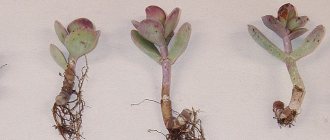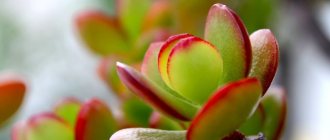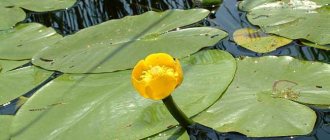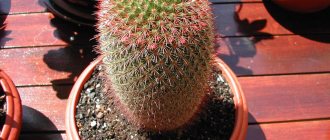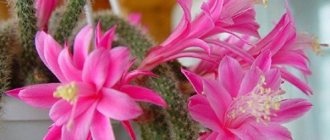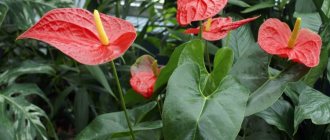Description and characteristics
Crassula perforata is a perennial plant reaching 3-4 meters in height. Shoots of this species die off after fruiting (except for the basal part, on which renewing buds are located). The flowers are small, whitish or yellow. In rare cases there are red and blue. Usually five-membered, but there are also single axillary ones. They are located in terminal or lateral paniculate-umbellate or racemose inflorescences.
The stamens are represented by opposite petals. The anther is ovoid or oblong. Nectar scales are small. Carpels are free or growing from the base. The ovary is longer than the style. Crassula perforatum grows primarily in South Africa and Madagascar in thicket vegetation and rocky slopes from Worcester in the west to the far east of KwaZulu-Natal.
Reference. Crassula perforata is also found in southern Arabia.
Crassula perforata grows with unbranched, long and wandering stems, not reaching a length of 20 cm. It has a thick and long trunk, on which are round and fleshy leaves with a pronounced bluish bloom. They have opposite layered leaf arrangement.
In bright sunlight, the edges of the leaves become reddish.
Crassula perforatum is an unpretentious flower. If you do not set out to get flowers, then it is enough to follow the rules of watering and plenty of daylight. Crassula quickly takes root and reproduces. Flowering requires low temperatures (10 – 12°C) and limited watering. The fat woman is a long-liver; with proper care, she will live at least 15 years.
Reproduction methods
There are several ways to propagate a money tree - from cuttings, leaves and seeds.
Cuttings
The cuttings are harvested in the spring. Take an adult and healthy plant, carefully separate the lateral shoots with several leaves from the stem. Place in a container with warm water.
Stems with roots are planted in a nutrient substrate.
Leaf
Roots may form on the leaves
Some leaves may produce thin roots. You can also get new plants from them. Carefully separate it from the stem along with the root, then plant it in a light and loose mixture of compost soil and sand (1:1). Moisten and cover with film.
Keep in greenhouse conditions until new leaves appear.
The seedlings are periodically moistened and ventilated. When they get stronger and grow 2-3 pairs of leaves, they are planted in clay pots.
Seeds
Seeds collected from an adult plant are sown in bowls or seedling boxes filled with a nutritious and light mixture of leaf soil and coarse sand (1: 0.5). Spray with warm water from a spray bottle, then cover with transparent film or glass.
The glass is removed after about 2 weeks, when sprouts appear. As soon as they grow and get stronger, they are dumped into separate containers - you can use disposable small cups with holes in the bottom.
For picking, take a mixture of turf, leaf soil and sand. Grow at home in a warm and well-lit place.
As soon as one pair of leaves appears on the plants, they are planted in pots with a diameter of 5-7 cm. They are kept at a temperature of 16-17°C for 2-3 weeks, then transferred to a permanent habitat with other flowers.
What varieties exist in this species: description and photo
Variegata
Crassula Variegata is a perennial, creeping plant with a branched stem reaching 60 cm in length. It has dark green shiny leaves, about 3-4 cm in length. Petiolate leaf arrangement. As you can see in the photo, the flowers are single, mostly blue. Fruits are rarely produced; vegetative propagation predominates through branching of rhizomes and pruning of shoots.
Important! Does not tolerate hot places, prefers shade and partial shade.
Minor
Crassula Minor is a fastidious and slow-growing plant. It grows as a compact and small bush. The color of the leaves ranges from light red, which turns into dark red during the life of the plant. The leaves are fleshy, shiny, green in color with a reddish edge, reaching 4 cm in length.
Alba
The leaves of Crassula Alba are oblong, shiny, smooth and without plaque. On average, the leaf length reaches 5-6 cm in length. The leaf color is reddish with a cream pattern, but green with a burgundy pattern is also found. The stem is shortened, but during the development of the peduncle they stretch 30-40 cm. Alba's leaf arrangement is a basal rosette.
Attention! During flowering, the rosette dries out - this is a feature of this variety.
Popular varieties
Kalanchoe at home + types and varieties
There are several varieties of indoor flowers, they differ in appearance and shape.
- Minor. This is a miniature variety - up to 30-40 cm in height, with glossy leaves pointed at the tips. Under good growing conditions, the trunk and leaves take on a reddish tone with age. With an excess of organic fertilizers, the decorative effect is lost.
- Oblikva. The variety was bred by domestic breeders. In Europe it is called lime or lemon. The main difference between the variety is the presence of stripes on the surface of the leaves, and their color can be different. The edges of all leaves are rich green. To achieve maximum decorativeness, you will need to provide two conditions - continuous lighting and coolness.
- Gollum, or hobbit. An old hybrid form, bred in the 70s by American breeders, based on the milky and ovate Crassula. The leaves are tubular and have a red edge at the end. They are narrow at the bottom, widened closer to the top. The plant is characterized by slow growth - it grows by 4-5 cm per year. The maximum height is 50 cm. The crown can be different - round, oval and completely shapeless.
- Sunset. Translated from English it means “sunset”. The leaves are bright - the main cover is emerald, with cream edges and purple edging. With a lack of light, they become a solid green color. In the wild it blooms from the beginning of March until the end of August with small flowers collected in brushes. There are specimens with yellow, blue or red tints. At home, flowering is observed extremely rarely.
- Tricolor. This is a variety of Crassula obliqua. The leaves are green with whitish stripes and a bright scarlet edge. The crown is spherical, consists of numerous shoots, densely covered with emerald foliage. The leaf blade is dense, fleshy, rounded, glossy.
- Horntree. This variety is distinguished by an unusual shape of leaves - as they grow, they curl around a central vein. The tips are reddish. In young specimens the trunk is deep pink, and with age it becomes covered with a dark brown crust.
- Variegata. A miniature plant with variegated foliage - the main color is light green, with an emerald stripe in the center. The leaves are oval with pointed tips.
Home care
| Lighting | Crassula perforata is located so that there is enough sunlight. But it is worth protecting the plant from direct sunlight, as it can cause burns, especially for young plants. |
| Temperature | In spring and summer, room temperature (20 – 23°C) is sufficient, but in autumn and winter the pot should be moved to a cool place (10 – 12°C). At night, the optimal temperature will be 12 – 14°C, in any season of the year. |
| Location | The plant should be placed on the east and southwest sides, and if all the windows in your apartment face the south, shade them with light protection. In summer, it is allowed to take the plant out onto the balcony. |
| Watering | Requires moderate watering. It will be enough once a week in the summer, and once every two weeks in the winter. Between waterings, the soil should dry out ≈ 3 cm deep. If water appears in the pan after watering, it must be drained. Stagnation of water is unacceptable. |
| Air humidity |
|
| Top dressing | At the beginning of spring, you can fertilize the plant with liquid mineral fertilizer for cacti and succulents, because they have a high content of potassium and phosphorus. For young plants, you can use nitrogen fertilizer in low concentration. It will stimulate the growth of leaves and stems. |
The soil should be light and peat-free. Drainage is also important; it must be tight. Approximate soil composition:
| |
| Trimming | In order for the plant to take on a bushy appearance, the tops of young stems (2–3 leaves) should be trimmed weekly. Apical cuttings can be rooted. |
| Diseases and pests |
To prevent the appearance of diseases and pests, use a weak solution of potassium permanganate. |
Reproduction
The flower is considered long-lived. It can grow for several decades and bloom with proper care. However, old and too massive plants suffer from broken roots, which are unable to support the branched stem. In addition, adult Crassulas “bald” in the lower part, which is why they do not look very attractive.
By pruning the plant and shaping it, you can achieve a reduction in upward growth and the formation of new side shoots, but propagation by shoots is considered a more effective method of total rejuvenation at home. In this case, you can grow a new specimen, which for at least 10 years will delight the owner with the juicy green color of the leaves and the compact size of the crown.
Reproduction of Crassula by cuttings:
- Take shoots with several leaves and dry them in the light for 24 hours.
- Plant in a ready-made soil mixture for succulents or in a mixture of turf and leaf soil with sand (2:1:1).
- Water moderately, wetting the earthen ball.
- Place the pot in a well-ventilated, bright room.
- The first year after planting, fertilizing is not needed.
Features of Crassula perforatum
There are three breeding options for Crassula.
Cuttings (shoots)
It is recommended to carry out cuttings of Crassula in the spring, during the activation of plant growth.
Rooting cuttings in the ground:
- Select strong cuttings with small leaves that reach at least 10 cm in length and cut them with a sharp knife.
- Treat the cutting with charcoal and leave it in the open air for a day.
- Place the shoot in a pot filled with loose soil, sprinkle the trunk, but do not compact it.
- Moisten the soil with a spray bottle.
Rooting leaves
Rooting leaves in water:
- Fill a low container with root stimulant solution.
- Cut the edge of the sheet and lower it 5 mm into the solution.
- When the first roots appear, plant the plant in a small container, and later in a pot with a diameter of no more than 7 cm.
Reference. During rooting of leaves, avoid direct sunlight!
Propagation by seeds
- The pot is filled with a soil mixture: 1 part leaf soil, 0.5 parts sand.
- The entire surface of the soil is covered with Crassula seeds and sprinkled with sand.
- The soil is moistened and covered with glass.
- Plantings are ventilated daily.
Reproduction methods
Crassula reproduces well in several ways. Each gardener can choose the most convenient one for himself.
Leaf
A new plant can be obtained from one leaf
Like any succulent, Crassula easily produces new shoots from a single leaf. The seed material is cut off and set aside to dry. It is better to put it on paper in a dark, warm place.
When the cut site dries, each leaf is placed in a special sand-turf substrate. It is possible to pre-dip them in the Kornevin solution. The top of the sheet is covered with a jar or whip. In a greenhouse it will be easier for it to take root and start growing.
Cuttings
This method is the most common. Several side branches are cut off from an adult plant, washed under running water and set aside to dry. It is better to take small branches with 5-6 leaves.
When the juice stops secreting, the cuttings are placed in water, dropping a little of the Kornevin preparation into it. After the roots appear, the cuttings are placed in the prepared substrate.
Some gardeners prefer to plant shoots in the ground immediately, without placing them in water. In this case, it is necessary to have a greenhouse and a more drained soil mixture, because it will be more difficult for roots to form in the ground. However, shoots rooted in the soil grow faster than after a container of water.
Aerial roots
Sometimes an adult Crassula forms roots directly on growing shoots. If this happens, you can easily separate the segment with the roots and immediately plant it in the ground. Such shoots take root the fastest and do not require special care. True, the plant does not always take down such aerial roots.
If the branches on an adult Crassula tree are all rooted, this is not a good sign. The plant lets you know that it is uncomfortable, cramped, and lacks moisture or microelements in the soil. Most often, replanting into a larger pot with nutritious soil helps solve this problem.
Seeds
The Hobbit variety is a hybrid, so collecting seeds from it and using it for subsequent planting is not practical. Even if you manage to get seedlings, it is not a fact that this particular succulent will grow.
The shoots may not retain the properties of the mother plant. In addition, Crassula seeds do not ripen properly at home. To do this, special conditions will have to be created.
What plants are similar to Crassula perforata?
- Graptopetalum paraguayense (Paraguayan Graptopetalum) - like Crassula Perforata, has diamond-shaped, fleshy and green leaves.
- Aichryson x domesticum (Aichryson home) - similar in leaves, size of the formed bushes, as well as a hybrid variety.
- Monanthes muralis (Monanthes wall) - succulent, green leaves, about 3 cm in length.
- Monanthes amydros (Monanthes amydros) - racemose inflorescences, evergreen leaves.
- Graptopetalum paraguayense (Paraguayan graptopetalum) - the leaves are covered with bluish wax, has a short and succulent stem.
Caring for a fat woman is not difficult. If you follow all the rules, then this plant will give you good growth, a beautiful appearance, and will also bring a lot of joy and decorate any interior. We invite you to learn how to grow such types of Crassula as Tree, Pursula, Sunset, Moss, Silver, Buddha Temple, Ovata, Hobbit and Gollum.
In conclusion, it is worth noting that in addition to its unusual appearance, unpretentiousness, longevity and ease of care, Crassula is widely used in medicine as an antimicrobial and antiviral agent.
Varieties of Crassula perforata
Two common varieties of Perforata can be easily found in garden centers and online. Let us describe their features.
Crassula perforata variegata
The epithet Variegata (“variegated”) refers to the presence of different colors of leaves. This variety has a variety of colors ranging from green to yellow and pink.
Some have rainbow edges while others have stripes.
Crassula perforata ssp. kougaensis
The subspecies of Crassula perforata is visually quite similar to the main plant. This is the smallest form of C. perforata. The leaves have bright reddish-pink edges.
They are also decorated with pink or white dots. There is also a variegated (Variegata) form of this flower subspecies.
Crassula perforata is often confused with Crassula conjunctae, whose leaves are slightly different in color and shape.
